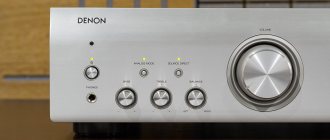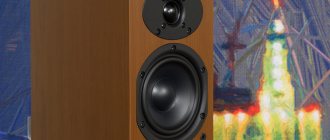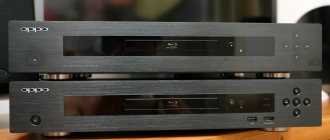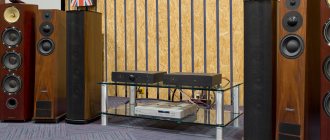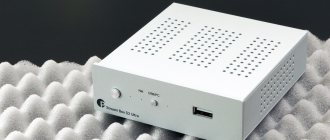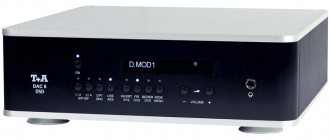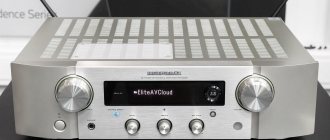For a Japanese company, especially one as reputable as Denon, tradition is incredibly important. On the other hand, wireless, multi-room and other fashion trends are noticeably crowding out classic hi-fi - here, as they say, it’s either change or die. The harmonious unification of these two worlds is an extremely difficult matter, but it is at the intersection of classics and innovations that truly interesting solutions are often born. These include a couple of rather extraordinary devices that I had the opportunity to become acquainted with.
Invisible figure
The corporate description of the two thousand five hundredth series especially emphasizes that both seasoned developers with extensive “analogue” experience and progressive youth were invited to create it. The idea is clear: to create a high-end hi-fi set in tune with the digital age.
SACD player Denon DCD-2500NE. No USB ports, absolutely classic design
The appearance of this pair does not in any way indicate that they belong to ultra-modern technologies - and this is even great, in my opinion. Looking at the polished aluminum and the harmonious arrangement of controls in anticipation of the moment the sound is born, you don’t think about the technical parameters at all.
The visual solidity is emphasized by its considerable mass: the player weighs almost 14 kg, and the amplifier - exactly 25. From these figures alone, it is easy to guess the presence of independent transformers for digital and analog circuits, and the massive vibration-absorbing metal plates at the base of the chassis.
AV receiver Denon AVR-X2500H
Surely, adherents of pure stereo will again write in the comments that AV receivers are only good for cinema. And we will again build, on the basis of an inexpensive multi-channel, a first-class music system that can outshine an expensive integrated source with a source. And for this we use some not very well-known methods of connecting acoustics.
How multi-channel technology has stepped forward over the past decade can be easily understood from the system menu - for a modern receiver it will be many times more complicated than for a model released in the early 2000s. The expansion of capabilities was achieved primarily due to increased performance of processors responsible for image and sound processing. HDMI switching with support for 4K and HDR, decoding of object-based audio formats, sophisticated algorithms for room correction, signal separation and individual adjustment - all this is available with the latest controllers and multi-core DSPs. Under the casing of even an inexpensive receiver today you will certainly see many huge chips, the performance of which is sometimes quite comparable to computer CPUs.
But this same powerful computing power can also be applied to solve problems inherent in all traditional two-channel systems.
Of course, the maximum benefit from the widest arsenal that advanced audio processing provides in a multi-channel receiver is extracted in serious systems that support formats like Dolby Atmos and DTS:X. But this same powerful computing power can also be applied to solve problems inherent in all traditional two-channel systems. We're talking about eliminating temporary mismatches in speaker response, reducing phase shifts and frequency response deviations, which inevitably bend at the listening point due to uneven dispersion of speakers, reflections from walls or low-frequency disturbances in the room.
In theory, bi- or tri-amping could be a panacea for all this. But not the simple one offered as one of the basic modes in receivers, but a more sophisticated one - with preliminary processor processing. In High End Audio, for example, Linn has such a solution. She suggests using the Exaktbox multi-channel digital block to separate each channel into different power amplifiers with certain delays and phase shifts in each frequency band according to algorithms written for specific models of speaker systems. Let us clarify that we are talking about the use of by-amping with speakers of the most common passive type. Some audiophiles consider this connection to be incorrect, since it is more logical to “cut” the frequency bands themselves before amplification in order to send the signal directly to the speakers, bypassing crossovers. But take my word for it, there are even more pitfalls in active division for “correct” by-amping. And what Linn has already implemented, and what we want to repeat with the Denon receiver, but for all speakers with separate connections of the bands, should be called something else - for example, active correction.
Without any fuss, we connect the low-frequency sections of the speakers to the “rear” outputs of the receiver, and the mid/high frequencies to the “front” outputs.
Even in practice it is done as easily as possible. Any receiver has an All Channel Stereo mode, when turned on, the same signal enters the rear channels as the front ones. And this, in principle, is already enough. We do not assign by-amping in the menu, but without any fuss we connect low-frequency sections of the speakers to the “rear” outputs of the receiver, and midrange/high frequencies to the “front” outputs (just don’t forget to remove the jumpers from the speakers). And as soon as All Channel Stereo is activated, our cleverly connected channels can already be considered as strips. The signal to them passes through the processor and can be subject to independent adjustments. The minimum that is available to us is to set the level and delays separately. The more adjustment capabilities the processor has, the more accurately we can control the correction. In a device with advanced auto-calibration, in theory, it is possible to achieve equalization of the frequency response, phase linearization, and neutralization of “standing” waves for a regular stereo pair of speakers... Isn’t it tempting?
We took the latest Denon AVR-X2500H receiver as a test subject. It already excelled in one of our tests with a system made up of Canton GLE monitors. And before our experiment, we also thoroughly warmed up with the complete 5.1.2 HECO Aurora kit, which we assembled to make sure that all the Audyssey self-tuning algorithms implemented in the receiver worked correctly. By the way, there were no problems with this - after the first run with measurements at three points instead of the full eight, the device found a common language with the acoustics, the room, and the subwoofer.
We made a conscious choice in favor of the middle model in the Denon seven-channel series. We were tempted to try the most affordable AVR-X1500H, but as we have already seen, this model is focused on cinematic sound. The more expensive AVR-X3500H is too rich in functionality for our simple experiment and does not provide any special advantages from an audiophile point of view. But the AVR-X2500H is what you need: an advanced 32-bit quad-core Cirrus Logic CS49844 is used as the “brain”, the output sections have the same vertical layout and are made with the same transistors as in the model of a higher class, and finally, they are the same even capacitance in the power supply (Nichicon 12000 µF/71 V). The only difference we find is in the transformer, which does not have a steel screen, and therefore is 200 g lighter (and it is much more powerful and massive than that of the 1500).
By the way, all of the new products listed above received an improved eco-mode, which significantly reduces power consumption during idle time (sometimes by almost half), and support for the Apple AirPlay 2 wireless multiroom protocol. Another important advantage compared to last year’s line is the integration of a phono stage into all models, which is for sure will delight music lovers who are partial to vinyl.
The main acoustics used in the experiments with by-amping were expensive audiophile systems Canton A45. How demanding they are on electronic components became clear after standard switching on without any multi-channel tricks. Even completely resetting all settings and switching the AVR-X2500H to Pure Direct mode did not add to the sound the desired plasticity and purity that the A45 is capable of. The standard by-amping, however, was already better - the dynamics in the low band increased, all the apparent images in the scene were more clearly defined. But there was still a feeling of inferiority - the strict and difficult German acoustics with an inexpensive receiver sounded bright and superficial.
It would seem that the intervention of the processor should have weakened the resolution of the audio path, but in fact it turned out the opposite.
By switching to the scheme described above (with the All Channel Stereo mode), this problem was solved even more effectively and simply than we imagined. A slight attenuation of the level in the channels of the mid/high frequency section gave the correct musical balance. And adjusting the distance in these bands (we selected it by ear - it’s optimal to set it 7 - 8 cm less relative to the bass ones) immediately literally put the second or third planes in place in the sound stage. Chic!
After these settings, by the way, the sources began to be distinguished much better. Previously, it was difficult to give preference to any of the players, but now the optically connected CD transport played demo CDs definitely more transparently and musically than the BD player via HDMI. It would seem that the intervention of the processor should have weakened the resolution of the audio path, but in reality the opposite happened - the ordering of the delays made it possible to hear more details and nuances.
The next step is to run auto-calibration on an external microphone. After this procedure, the tract sounded with some excess boominess, which is not surprising - the system detected an insufficient level of low frequencies in the mid/high frequency section and tried to correct it. But we have two more very useful tools at our disposal. In the menu of Denon receivers, you can change the type of Audyssey frequency correction – Flat or Reference (the latter gives a slight attenuation of “harsh” high frequencies, which is useful for harsh cinema effects). You can also leave the correction for only one pair (L/R Bypass), that is, in our case, turn off the frequency response equalization in the upper section, but leave it for the low band.
The emotional component of the playback was expressed so strongly that it was difficult to stop listening!
And it was this mode that turned out to be the most musical for the test tandem. It is difficult to find analogues for the results obtained. Judging by the light tint and slightly enlarged space, it was felt that the signal was converted to analog and amplified by an inexpensive component, which still slightly lacked musical pedantry. However, the emotional component of the playback was expressed so strongly that it was difficult to stop listening! The bass section has taken on excellent shape. Both lively softness and colorful texture appeared in the vocal range. Luxurious free dynamics emerged at the highs. Depth, air, scale... Let a discerning music lover listen to this, and he will never believe that all this was produced not by a stereo amplifier for a couple of thousand euros, but by a Denon receiver three times cheaper...
And a couple more observations. Auto-calibration determined that the difference to synchronize the response of the speakers in the A45 should be slightly less than what we previously found experimentally (it was set to 3 - 4 cm). She lowered the levels of the mid/high frequency bands by as much as 4 dB. Where do such discrepancies come from? Most likely, the Audyssey system cut local frequencies in the bass band by about the same amount in order to neutralize the influence of modes in the room.
A curious result is also obtained with a “mirror” by-amping connection, when the signal from the front channels is routed to the bass sections, and from the rear channels to the top sections. The influence of auto-correction in this case is almost not visible at the lowest register, but has a stronger effect on the rest of the band. This is the most effective way to make inexpensive speakers with significant frequency response deviations sound linear.
In a good way, receiver manufacturers should have made bi-amping (or even tri-amping) a long time ago as a standard function with ready-made settings and the correct calibration algorithm so that it would be understandable to any user. We hope that Denon will be the first to implement this thing. The idea has already been tested.
SYSTEM
- Sources BD player Denon DBT-3313UD
- CD player Denon DCD-520AE
- laptop Apple MacBook Air A1465
- NAS storage Synology DS 115
- Canton A45 (for stereo)
- digital InAkustik Exzellenz High Speed HDMI 2.0 and Oehlbach XXL Series 80 TOSLink
Denon AVR-X2500H
Manufacturer: D&M Holdings Inc (Japan)
www.denon.ru
Inputs: 8 HDMI, 2 Video Composite, 2 Video Component, Phono, 4 RCA, 2 TOSLink, USB Type A, LAN || Outputs: 2 HDMI, Video Composite, Video Component, RCA, 2 Sub, 6.3 mm Phones || Wireless protocols: HEOS, WiFi Audio Streaming (AirPlay, AirPlay 2, Windows PlayTo), A2DP Bluetooth || Supported formats: mp3, AAC, WMA, WAV, FLAC, ALAC, AIFF, DSD2.8/5.6 || Signal to noise ratio: 100 dB || Load resistance: 4 – 16 Ohm || Number of power amplifiers: 7 || Output power: in stereo mode 2 x 125 W (6 Ohms), in one channel - up to 150 W (6 Ohms) || Power consumption: 500 W || Dimensions: 434 x 167 x 339 mm || Weight, kg: 9.4 || Price: 49,990 rub.
share
Tags: DenonDenon AVR-X2500HExpert's Choice
Delicacy stereo
The DCD-2500NE is the top SACD player in Denon's European line. At home, the company offers even more advanced devices, but our hero is clearly created by audiophiles and for audiophiles.
Amplifier Denon PMA-2500NE. The volume control isn't just impressive, it's huge and almost hypnotically arresting.
Effective suppression of the slightest vibrations is ensured by the Master Mechanical Ground Construction, which includes reinforcement of the chassis with two 1.6 mm steel sheets and additional mechanical isolation of the supply transformers. The top of the case is protected by a two-layer panel made of steel and copper.
The proprietary disc drive features an Advanced SVH hybrid mechanism that utilizes vibration-absorbing coatings and resonant mismatched parts encased in 2mm steel. The center of mass of the rotating block is shifted as far down as possible, again with the goal of creating as little mechanical interference as possible.
Before us is an uncompromising SACD player Denon DCD-2500NE, so nothing superfluous
The power supply uses high-quality electrolytes (total capacity for analog circuits is 3300 µF). Signal circuits use custom capacitors with polyphenylene sulfide dielectric, known for its durability and extreme temperature stability. During the development process, the supplier repeatedly sent samples of them to Denon specialists for listening.
Separate boards, transformers on a separate platform and a SACD drive hidden in a solid box
The length of the signal chains is carefully minimized, and a pair of clock generators located in close proximity to the DAC are provided to combat jitter. They are used at different sampling frequencies, multiples of 44.1 and 48 kHz, respectively.
Digital-to-analog conversion is handled by a 32-bit (both in internal structure and in maximum signal capacity) PCM1795 chip from Texas Instruments. It processes digital streams up to 192 kHz inclusive, and uses the latest version of Denon's Advanced AL32 Processing Plus algorithm to more accurately restore the analogue signal shape. As a result of his work, listeners are promised (literally): improved detail, absence of distortion, precise localization, expressive bass and sound fidelity.
The transformers in the Denon PMA-2500NE amplifier are rotated 180 degrees relative to each other
The progressive digital essence of the DCD-2500NE lies in the ability to play not only Audio CD and Super Audio CD formats, but also PCM music files up to 192 kHz/24-bit, as well as DSD 2.8/5.6 MHz. However, the USB port and digital inputs found in the predecessor DCD-2020 are absent here, and music can only be played from DVD±R/RW discs, or from CD-R/RW, if the sampling frequency does not exceed 48 kHz.
To be fair, I note that the DCD-2020 did not have such extensive disk capabilities, and digital inputs are available in the new integrated device. And one more subtlety - the sound path is stereophonic, which means that SACD discs with a recorded multi-channel track will only be played in stereo.
Denon DCD-2500NE turntable and PMA-2500NE amplifier
The more you learn about the new line of Denon 2500 series hi-fi components, the stronger the desire to try it out. I wonder if the company from Kawasaki, in the suburbs of Tokyo, managed to prepare a dish in which classic recipes for high-quality sound were harmoniously combined with the modern “molecular cuisine” of digital technology?
A seemingly ordinary event – an update of the model range. But without knowing anything about the successors, you immediately ask the question: why did the series receive the index “2500” and not continue the previous numerical sequence “2000”, “2010”, “2020”?
People with knowledge of the company's internal affairs say that several people from the old analog guard have returned to the development department. And together with young engineers experienced in digital sound, they decided to create a “new era” technique. The hyperbole is loud and, by the way, not without slyness (if only because the Japanese Denon range has cooler components that Europe and America have never even seen), but the fact remains that a qualitative leap has taken place. The numbering with a pass seems to hint at it.
The terminal circuits are extremely laconic - each channel is a single push-pull cascade based on UHC field-effect transistors, capable of delivering current up to 210 amperes at peak.
Using the example of the PMA-2500NE integrated circuit, the synergy between digital and analog can be seen at first glance. Now it is a half-digital device, equipped with a modern USB converter on a 32-bit Burr-Brown PCM-1795 chip with galvanic isolation and a circuit for suppressing interference coming from the computer. A small OLED display was installed on the front panel, which does not create interference. They also provided a purely analog mode, when turned on, all digital paths are de-energized.
But the rest is implemented even more curiously. Mechanically, the amplifier is divided into six independent blocks with direct attachment to the chassis, which in turn is additionally reinforced with steel sheets. Take a look at the characteristics table: weight 25 kg! Volume adjustment is performed without digital shamanism, but with a classic high-precision potentiometer. The power supply system contains paired massive transformers with minimal losses and separate rectifiers using powerful Schottky diodes. Along the entire signal path, control and protection circuits have been eliminated (it is carried out in new ways without interfering with the audio path), as well as almost all interstage capacitors. In other words, the PMA-2500NE path is a DC amplifier - a DC amplifier. And the terminal circuits are extremely laconic - each channel is a single push-pull cascade based on UHC field-effect transistors, capable of delivering current up to 210 amperes at peak.
The short path concept is also implemented in the DCD-2500NE player. After revising the circuitry, everything unnecessary was removed from the device. In the analog part, new “sound” capacitors were used, independent power circuits were organized with separate transformers for digital and analog circuits. Particular attention is paid to mechanics. The proprietary SVH drive received a modernized suspension and a massive base made of a solid compound reinforced with fiberglass.
Just as the chassis of the integrated vehicle was strengthened with steel plates, here a solid three-layer “sandwich” was assembled. Plus, they used “mechanical grounding” technology, which suppresses vibrations of both electrical (from power transformers) and acoustic origin. The digital section of the player includes PCM-1795 converters, already familiar from the amplifier, with Denon’s Advanced AL32 Plus interpolation algorithms and a pair of Master Clock clock generators with an improved power supply circuit for even more stable operation.
“Mechanical grounding” technology suppresses vibrations of both electrical (from power transformers) and acoustic origin.
I can’t wait to start listening, but I’ll add a couple more words. It would be very interesting to try out the third component from the new series - the multi-format network player/converter DNP-2500NE, which also provides wireless Wi-Fi connectivity with AirPlay support. But this model is currently offered only for the Japanese market.
If we talk about signal transmission via conventional wired protocols, then all of the above components can accept PCM with a bit depth of up to 192 kHz/24 bits or a single-bit DSD stream of standard, double or quadruple frequency (2.8/5.6/11.2 MHz) . By the way, when connected via USB to an Apple laptop, the latter’s MIDI subsystem generally offers “friending” at 706.6 or 768 kHz, which is 16 times higher than the standard quantization of 44.1 or 48 kHz. It's nice to see that the computer has found such an advanced partner in Denon, but I recommend not to fall for these flattering offers and choose the original sampling rate with which the played files are digitized. Software upsampling cannot add useful musical information, and the load on the asynchronous USB channel will definitely increase, which is only fraught with transmission errors.
But first I'll listen to music the old fashioned way. Between the source and the amplifier there is a traditional connection via a linear input. The player contains a regular CD, the integrated circuit is switched to analog mode. In short, the sound can be described as follows: very open, free, clear. The space is almost immaculate, and only on the flanks of the stage is some blurring of depth detected. The top is dry and rich in air. The detailing is great across the entire range. The bass is pleasant - a little more rounded than we would like, but quite detailed and temperamental. In the lower middle and higher, the sound has velvety and even gentle shades. There is almost no digital tint characteristic of PCM 44.1. But there is still a bit of synthetic quality in the reproduction. I attribute this to the specifics of the AL32 algorithm, which gave the sound a certain “varnish” in Denon digital technology of previous generations.
Same configuration, but SACD is loaded into the player. But now it’s good... I would even say luxurious! In space, precision is of a completely different order - unprecedented diversity and imagery. More details. Lots of tonal shades. The top is impeccable in terms of information content. And all this adds up to a natural, easy-to-understand picture! The realization of a simple fact comes: discs with DSD were not appreciated at their merits only because the playback equipment, even quite expensive, was not able to reveal the full musical potential of the medium. Here there is a minimum of sterility and a maximum of approximation to something natural - the music is reproduced in all the fullness of its own, and not of introduced colors. But for some reason - not at full dynamic support. The bass register lacks speed and muscularity.
In the lower middle and higher, the sound has velvety and even gentle shades. There is almost no digital tint characteristic of PCM 44.1.
In the third approach to the system, the source becomes a laptop connected directly to the amplifier via USB, from which I play sample files of the highest quality and resolution (DXD 384 kHz, DSD 5.6 MHz). The aesthetic side does not change. Everything sounds the same as with SACD, that is, with unrealistic naturalism. In technical terms, improvements are perceived rather on an intuitive level. All small sound details, echoes, creaks, rustlings became not only better audible, but more “visible” in the scene. But with the dynamics in the lower band there is the same problem - some relaxation.
I was lucky that the day of the audition I could try other acoustics. We transferred speaker cables from Canton Reference 5 K to Tannoy Revolution XT 8F, and from the very first seconds it became clear that the amplifier gets along much better with this particular load. Scottish systems with fast, responsive drivers and simple filters outperformed complex higher-end German systems in some respects. The music acquired drive, the bass acquired clear structure. But you should not take what has been said as a direct recommendation; each combination will have its own strengths. In a good way, for the PMA-2500NE, despite its energy performance, the acoustics must be selected carefully, listening to all aspects of the sound in different musical genres.
Lots of tonal shades. The top is impeccable in terms of information content. And all this adds up to a natural, easy-to-understand picture!
By the way, I’m ready to believe that old-school specialists worked on fine-tuning this pair. Such a sound signature could only be instilled in devices by people who still remember what acoustics were considered cool about forty years ago.
For which special thanks to them!
SACD player Denon DCD -2500 NE
Supported formats: SACD, CD-Audio, CD-R/RW, mp3, AAC, WMA, PCM 192 kHz/24 bit, DSD 2.8/5.6/11.2 MHz || Outputs: linear, coaxial, optical TOSLink || CD/SACD playback range: 2 – 20,000/2 – 50,000 Hz || Dynamic range CD/SACD: 118/120 dB || Signal-to-noise ratio CD/SACD: 101/112 dB || CD/SA-CD distortion level: 0.0015/0.0008% || Dimensions: 434 x 335 x 138 mm || Weight: 13.7 kg || Price: 214990 rub.
Integrated amplifier PMA -2500 NE
Inputs: Phone MM/MC, 5 x RCA, Direct In, 2 x Coax, 2 x TosLink (192 kHz/24 bit), USB-B (384 kHz/32 bit, DSD 2.8/5.6 MHz) | | Outputs: PreOut, Recorder, Phones || Input Impedance: 100 ohms (MC), 47 kohms (MM/Line) || Output power: 2 x 80 W (into 8 ohm load), 160 W (4 ohm) || Distortion: 0.01% || Signal to noise ratio: 110 dB, 89/74 dB (MM/MC) || Power consumption: 310 W || Dimensions: 434 x 431 x 181 mm || Weight: 25 kg || Price: 229990 rub.
COMPONENTS
- Laptop Apple MacBook Air A1465
- Speaker systems Canton Reference 5K, Tannoy Revolution XT 8F
- Cables: Digital Blue Dual Shield USB 2.0 AB
- interblock InAkustik Referenz Selection NF-2404
- acoustic InAkustik Referenz Selection LS-2404
- power InAkustik AC-1502 and P6
share
Tags: Denon
Not with the same power
The PMA-2500NE integrates the “Simple & Straight” concept, that is, everything is simple and without unnecessary elements in the signal path. The device is built on the principle of direct current amplification, and the final section of each channel is a single push-pull stage based on high-ampere field-effect transistors (UHC-MOS FET).
Two transformers are used for power supply (double mono with separate windings for digital). The rectifiers are assembled using new high-power Schottky diodes, which differ from conventional ones in their low voltage drop during direct connection and extremely short recovery time, resulting in a noticeable reduction in the noise level in analog power supplies.
The connection kit of the Denon PMA-2500NE amplifier is almost exhaustive, but balanced inputs certainly wouldn’t hurt
To prevent the output stage protection system from worsening the dynamic performance, it was decided to abandon current control, replacing it with monitoring the temperature of the output transistors with minimal response time. As a result, the peak operating current can reach 110 A, and the dumping factor exceeds 700 for the range 20 Hz - 20 kHz. In addition, high-speed temperature compensation stabilizes quiescent currents, which has a positive effect on sound clarity.
Like the DCD-2500NE, Direct Mechanical Ground Construction is used to suppress vibration, and the electronics are mounted on six independent boards to combat noise and interference. For the same reason, a small OLED panel is used for display, and, unlike electroluminescent displays, it causes almost no interference.
The switchable tone block of the Denon PMA-2500NE amplifier is configured for frequencies of 100 Hz and 10 kHz
The impressive volume control knob is connected to an analog potentiometer, which again makes it possible to avoid complication of the path. The thickness of the walls of the aluminum cylinder is two and a half times greater than in simpler models, but if I were the designers, I would not skimp and use a handle machined from a solid aluminum casting. In this case, the tactile sensations from communicating with the device would be much better.
Unexpected meeting
And again we move from the classics to digital modernity. It would seem that in appearance and characteristics the PMA-2500NE is the very embodiment of the analog spirit. So it is, but let’s not forget about the engineers of the “D” generation, called upon to modernize the ideas of the patriarchs. Apparently, it was they who equipped the amplifier with an advanced DAC, built on the same PCM1795 chip.
The electronics of the Denon PMA-2500NE amplifier are assembled on six independent boards
Here, of course, the proprietary Advanced AL32 Processing Plus signal interpolation technology is also implemented, and incoming digital streams are supported up to 384 kHz/32 bit (PCM) and 11.2 MHz (DSD). You can connect to the DAC via optical, coaxial or USB, and in the latter case, a “Digital Isolator” is used - a filter that prevents high-frequency interference from the computer from penetrating into the amplifier.
Let's listen
The role of test acoustics was played by the new Focal model - Sopra No. 2. Externally reminiscent of the flagship Utopia, these floorstanding speakers, by the way, have already received an EISA award in the category of the best High-End speakers.
I started with the classics: one of the early CD editions of “Carmina Burana” by Carl Orff - EMI Classics, 1997. The complex of complex dynamic and spectral intricacies of a symphony orchestra and two choirs was performed more than worthy by the set. High-quality detail allows you to easily highlight the sound of individual voices and instruments, of course, to the extent provided for by the score. At the same time, the solidity of the sound does not suffer, and high frequencies do not seem overly emphasized.
The remote controls of both devices are metal, with small but very ergonomic buttons
The spatial picture is also impressive, and its scale and depth were confidently read both in the Babylonian pandemonium of “Carmina Burana” and in the recording of a completely different kind - “Ways not to lose” by the blues duo The Wood Brothers. It was as if the brothers were actually standing in front of me, or rather, the double bassist was standing, and the guitarist, no doubt, was sitting. Perhaps the virtual double bass was somewhat larger than the real spatial proportions, but it gave the impression that each of its strings could be felt with your fingers. The bass is powerful and deep, however, its attack seemed a little flattened to me.
To fully experience the capabilities of the DAC in the DCD-2500NE, I switch to SACD discs. The timbre block in the amplifier, of course, is turned off, and Analog Mode, which disables digital circuits and indication, is, on the contrary, activated.
Due to numerous metal screens and partitions, the SACD player tray had to be extended
The changes in the sound were expected, but their scale was frankly surprising. High frequencies become even more transparent and cleaner. The vocal range is revealed incredibly, and for this special thanks should be given to the beryllium tweeters installed in Sopra No. 2. The effect of enabling Advanced AL32 Processing Plus is also present here and is expressed in slightly more accurately designed instrumental tones. The character of bass plasticity with slightly softened (literally on the verge of audibility) attacks is preserved, although there are no problems with depth: it was clearly limited by the impressive, but still not infrasonic, capabilities of a pair of seven-inch drivers in Sopra No. 2.
Playing high-res audio through the amplifier's DAC (source: Apple MacBook Pro laptop) brought virtually no differences in sound, which is not surprising, considering the same DAC chips, circuitry, and digital stream processing algorithms.
SECRET RECEPTION
How multi-channel technology has stepped forward over the past decade can be easily understood from the system menu - for a modern receiver it will be many times more complicated than for a model released in the early 2000s. The expansion of capabilities was achieved primarily due to increased performance of processors responsible for image and sound processing. HDMI switching with support for 4K and HDR, decoding of object-based audio formats, sophisticated algorithms for room correction, signal separation and individual adjustment - all this is available with the latest controllers and multi-core DSPs. Under the casing of even an inexpensive receiver today you will certainly see many huge chips, the performance of which is sometimes quite comparable to computer CPUs.
Of course, the maximum benefit from the widest arsenal that advanced audio processing provides in a multi-channel receiver is extracted in serious systems that support formats like Dolby Atmos and DTS:X. But this same powerful computing power can also be applied to solve problems inherent in all traditional two-channel systems. We're talking about eliminating temporary mismatches in speaker response, reducing phase shifts and frequency response deviations, which inevitably bend at the listening point due to uneven dispersion of speakers, reflections from walls or low-frequency disturbances in the room.
In theory, bi- or tri-amping could be a panacea for all this. But not the simple one offered as one of the basic modes in receivers, but a more sophisticated one - with preliminary processor processing. In High End Audio, for example, Linn has such a solution. She suggests using the Exaktbox multi-channel digital block to separate each channel into different power amplifiers with certain delays and phase shifts in each frequency band according to algorithms written for specific models of speaker systems. Let us clarify that we are talking about the use of by-amping with speakers of the most common passive type. Some audiophiles consider this connection to be incorrect, since it is more logical to “cut” the frequency bands themselves before amplification in order to send the signal directly to the speakers, bypassing crossovers. But take my word for it, there are even more pitfalls in active division for “correct” by-amping. And what Linn has already implemented, and what we want to repeat with the Denon receiver, but for all speakers with separate connections of the bands, should be called something else - for example, active correction.
Even in practice it is done as easily as possible. Any receiver has an All Channel Stereo mode, when turned on, the same signal enters the rear channels as the front ones. And this, in principle, is already enough. We do not assign by-amping in the menu, but without any fuss we connect low-frequency sections of the speakers to the “rear” outputs of the receiver, and midrange/high frequencies to the “front” outputs (just don’t forget to remove the jumpers from the speakers). And as soon as All Channel Stereo is activated, our cleverly connected channels can already be considered as strips. The signal to them passes through the processor and can be subject to independent adjustments. The minimum that is available to us is to set the level and delays separately. The more adjustment capabilities the processor has, the more accurately we can control the correction. In a device with advanced auto-calibration, in theory, it is possible to achieve equalization of the frequency response, phase linearization, and neutralization of “standing” waves for a regular stereo pair of speakers... Isn’t it tempting?
We took the latest Denon AVR-X2500H receiver as a test subject. It already excelled in one of our tests with a system made up of Canton GLE monitors. And before our experiment, we also thoroughly warmed up with the complete 5.1.2 HECO Aurora kit, which we assembled to make sure that all the Audyssey self-tuning algorithms implemented in the receiver worked correctly. By the way, there were no problems with this - after the first run with measurements at three points instead of the full eight, the device found a common language with the acoustics, the room, and the subwoofer.
We made a conscious choice in favor of the middle model in the Denon seven-channel series. We were tempted to try the most affordable AVR-X1500H, but as we have already seen, this model is focused on cinematic sound. The more expensive AVR-X3500H is too rich in functionality for our simple experiment and does not provide any special advantages from an audiophile point of view. But the AVR-X2500H is what you need: an advanced 32-bit quad-core Cirrus Logic CS49844 is used as the “brain”, the output sections have the same vertical layout and are made with the same transistors as in the model of a higher class, and finally, they are the same even capacitance in the power supply (Nichicon 12000 µF/71 V). The only difference we find is in the transformer, which does not have a steel screen, and therefore is 200 g lighter (and it is much more powerful and massive than that of the 1500).
By the way, all of the new products listed above received an improved eco-mode, which significantly reduces power consumption during idle time (sometimes by almost half), and support for the Apple AirPlay 2 wireless multiroom protocol. Another important advantage compared to last year’s line is the integration of a phono stage into all models, which is for sure will delight music lovers who are partial to vinyl.
The main acoustics used in the experiments with by-amping were expensive audiophile systems Canton A45. How demanding they are on electronic components became clear after standard switching on without any multi-channel tricks. Even completely resetting all settings and switching the AVR-X2500H to Pure Direct mode did not add to the sound the desired plasticity and purity that the A45 is capable of. The standard by-amping, however, was already better - the dynamics in the low band increased, all the apparent images in the scene were more clearly defined. But there was still a feeling of inferiority - the strict and difficult German acoustics with an inexpensive receiver sounded bright and superficial.
By switching to the scheme described above (with the All Channel Stereo mode), this problem was solved even more effectively and simply than we imagined. A slight attenuation of the level in the channels of the mid/high frequency section gave the correct musical balance. And adjusting the distance in these bands (we selected it by ear - it’s optimal to set it 7 - 8 cm less relative to the bass ones) immediately literally put the second or third planes in place in the sound stage. Chic!
After these settings, by the way, the sources began to be distinguished much better. Previously, it was difficult to give preference to any of the players, but now the optically connected CD transport played demo CDs definitely more transparently and musically than the BD player via HDMI. It would seem that the intervention of the processor should have weakened the resolution of the audio path, but in reality the opposite happened - the ordering of the delays made it possible to hear more details and nuances.
The next step is to run auto-calibration on an external microphone. After this procedure, the tract sounded with some excess boominess, which is not surprising - the system detected an insufficient level of low frequencies in the mid/high frequency section and tried to correct it. But we have two more very useful tools at our disposal. In the menu of Denon receivers, you can change the type of Audyssey frequency correction – Flat or Reference (the latter gives a slight attenuation of “harsh” high frequencies, which is useful for harsh cinema effects). You can also leave the correction for only one pair (L/R Bypass), that is, in our case, turn off the frequency response equalization in the upper section, but leave it for the low band.
And it was this mode that turned out to be the most musical for the test tandem. It is difficult to find analogues for the results obtained. Judging by the light tint and slightly enlarged space, it was felt that the signal was converted to analog and amplified by an inexpensive component, which still slightly lacked musical pedantry. However, the emotional component of the playback was expressed so strongly that it was difficult to stop listening! The bass section has taken on excellent shape. Both lively softness and colorful texture appeared in the vocal range. Luxurious free dynamics emerged at the highs. Depth, air, scale... Let a discerning music lover listen to this, and he will never believe that all this was produced not by a stereo amplifier for a couple of thousand euros, but by a Denon receiver three times cheaper...
And a couple more observations. Auto-calibration determined that the difference to synchronize the response of the speakers in the A45 should be slightly less than what we previously found experimentally (it was set to 3 - 4 cm). She lowered the levels of the mid/high frequency bands by as much as 4 dB. Where do such discrepancies come from? Most likely, the Audyssey system cut local frequencies in the bass band by about the same amount in order to neutralize the influence of modes in the room.
A curious result is also obtained with a “mirror” by-amping connection, when the signal from the front channels is routed to the bass sections, and from the rear channels to the top sections. The influence of auto-correction in this case is almost not visible at the lowest register, but has a stronger effect on the rest of the band. This is the most effective way to make inexpensive speakers with significant frequency response deviations sound linear.
In a good way, receiver manufacturers should have made bi-amping (or even tri-amping) a long time ago as a standard function with ready-made settings and the correct calibration algorithm so that it would be understandable to any user. We hope that Denon will be the first to implement this thing. The idea has already been tested.
